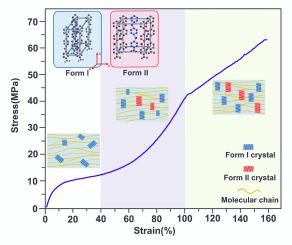Mechanism of structural evolution during thermal stretching of PEEK
IF 4.5
2区 化学
Q2 POLYMER SCIENCE
引用次数: 0
Abstract
Poly (ether ether ketone) (PEEK) is widely utilized due to its outstanding properties. Elucidating the conformational changes of PEEK under mechanical stress and their impact on crystalline morphology will offer an in-depth and systematic insight into the processing behavior of the poly (arylether ketone ketone) family. This study utilizes in-situ WAXD/SAXS and FTIR analyses, complemented by DSC characterization, to systematically explore the mechanism of aggregated state structure evolution in PEEK films subjected to high-temperature stress fields. Findings from the in-situ WAXD/SAXS tests indicate that the PEEK molecular chains orient along the direction of applied stress, which induces crystal fragmentation or melting. During the strain-hardening stage of thermal stretching process, the molecular orientation increases linearly with strain, along with the formation of form II crystalline structures. Higher strain and elevated stretching temperatures favor the formation of form II crystals. According to in-situ FTIR measurements, the movement of ether bonds during stretching triggered conformational changes that strengthened intermolecular interactions within the PEEK molecular chains. The DSC analysis demonstrated that form II crystals possess a higher melting temperature and enhanced stability. This work not only enriches the theoretical system of poly (arylether ketone ketone) series, but also provides a detailed theoretical basis for regulating the processing performance of PEEK.

PEEK热拉伸过程中结构演化机理研究
聚醚醚酮(PEEK)由于其优异的性能得到了广泛的应用。阐明PEEK在机械应力下的构象变化及其对结晶形态的影响,将为深入系统地了解聚芳醚酮酮家族的加工行为提供帮助。本研究利用原位WAXD/SAXS和FTIR分析,并结合DSC表征,系统探讨了高温应力场作用下PEEK薄膜中聚集态结构演化的机理。原位WAXD/SAXS测试结果表明,PEEK分子链沿着施加应力的方向定向,导致晶体破碎或熔化。在热拉伸过程的应变硬化阶段,分子取向随应变线性增加,并形成II型晶体结构。较高的应变和拉伸温度有利于II型晶体的形成。根据现场FTIR测量,拉伸过程中醚键的运动引发了构象变化,加强了PEEK分子链内的分子间相互作用。DSC分析表明,II型晶体具有更高的熔化温度和更强的稳定性。这项工作不仅丰富了聚芳醚酮酮系列的理论体系,而且为调控PEEK的加工性能提供了详细的理论依据。
本文章由计算机程序翻译,如有差异,请以英文原文为准。
求助全文
约1分钟内获得全文
求助全文
来源期刊

Polymer
化学-高分子科学
CiteScore
7.90
自引率
8.70%
发文量
959
审稿时长
32 days
期刊介绍:
Polymer is an interdisciplinary journal dedicated to publishing innovative and significant advances in Polymer Physics, Chemistry and Technology. We welcome submissions on polymer hybrids, nanocomposites, characterisation and self-assembly. Polymer also publishes work on the technological application of polymers in energy and optoelectronics.
The main scope is covered but not limited to the following core areas:
Polymer Materials
Nanocomposites and hybrid nanomaterials
Polymer blends, films, fibres, networks and porous materials
Physical Characterization
Characterisation, modelling and simulation* of molecular and materials properties in bulk, solution, and thin films
Polymer Engineering
Advanced multiscale processing methods
Polymer Synthesis, Modification and Self-assembly
Including designer polymer architectures, mechanisms and kinetics, and supramolecular polymerization
Technological Applications
Polymers for energy generation and storage
Polymer membranes for separation technology
Polymers for opto- and microelectronics.
 求助内容:
求助内容: 应助结果提醒方式:
应助结果提醒方式:


